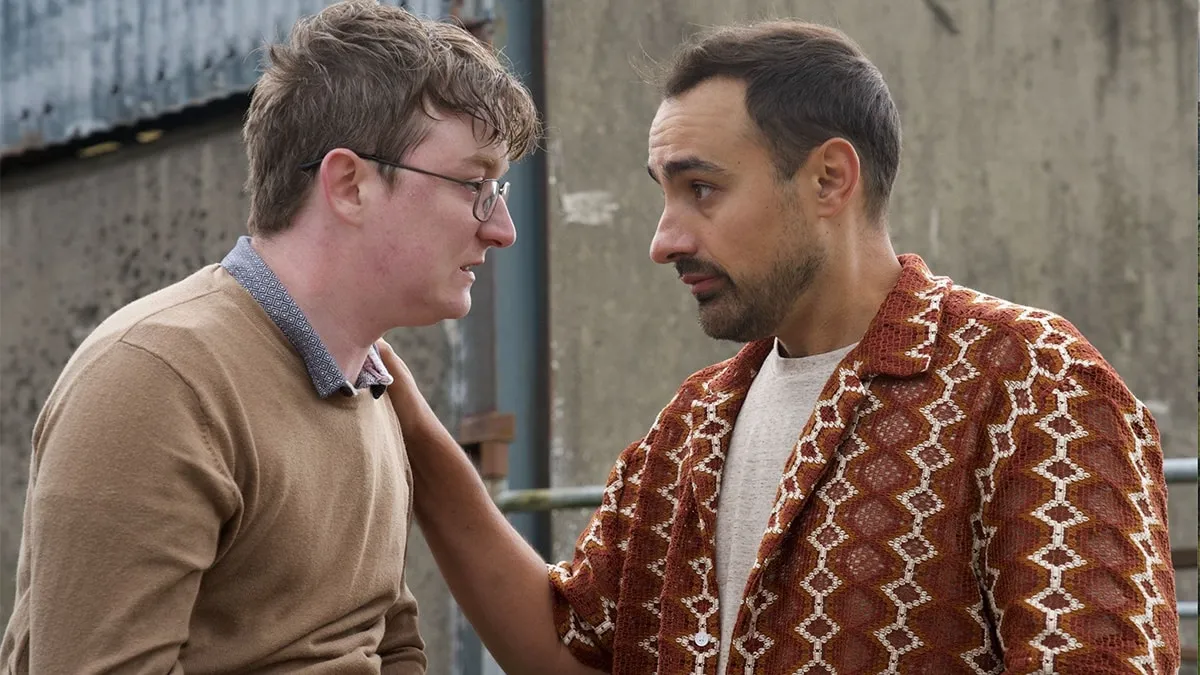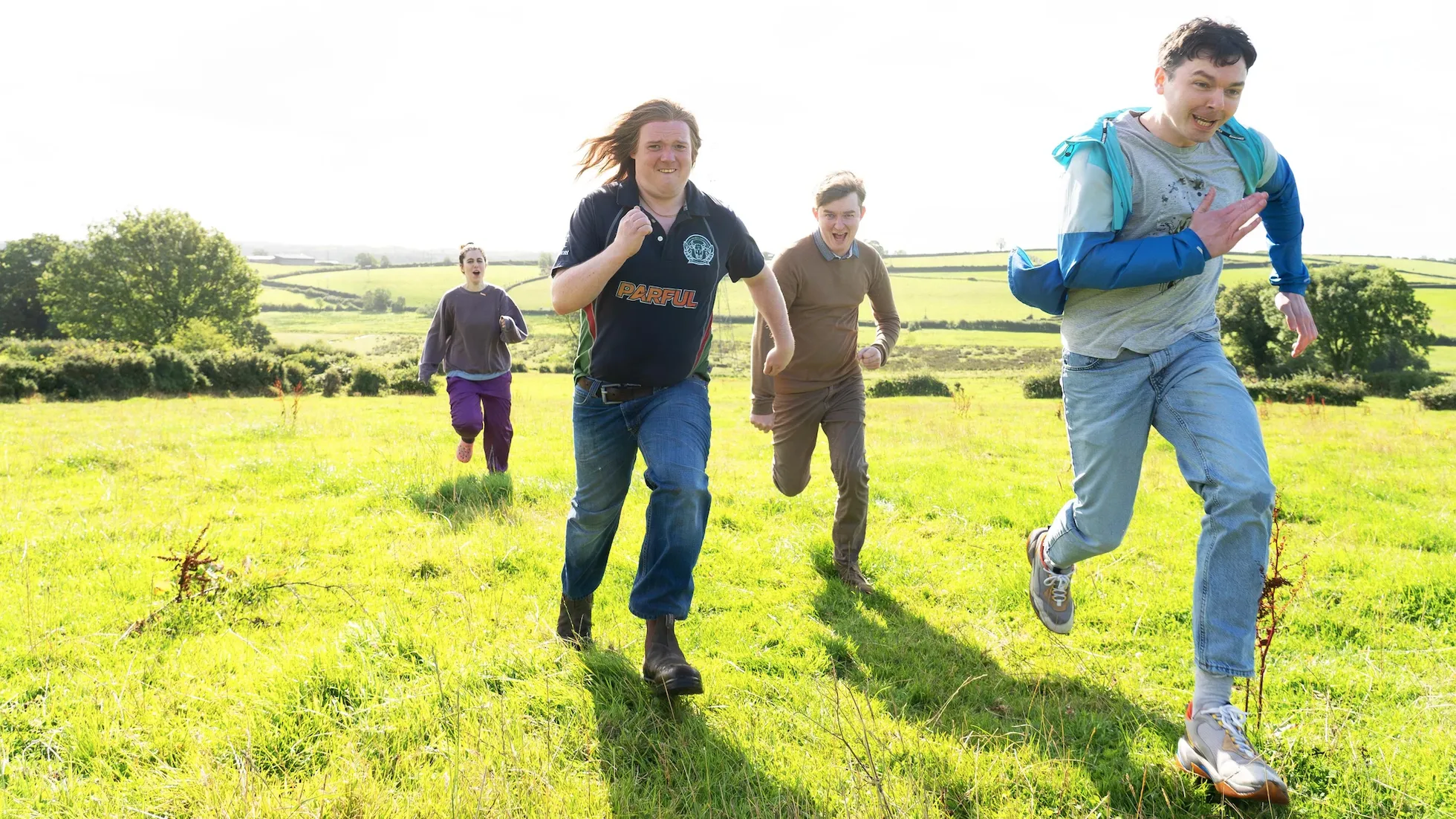Funboys began as a 2023 BBC Three short that quietly stole its way into my heart, then grew into four tightly wound, twenty‑minute episodes on BBC One and iPlayer. Created, written, directed by—and starring—Ryan Dylan and Rian Lennon, it feels like an indie experiment that accidentally hit the mainstream sweet spot.
From those first sweeping shots of emerald pastures and Guinness‑swigging locals, the series teases pastoral calm before dropping us into a dimly lit living room where Callum, Jordan and Lorcan wage war over video‑game controllers and fizzy‑drink challenges.
At its core, Funboys operates in mockumentary territory but rejects the safety of talking‑head interviews. Instead, it stitches together sketch‑style vignettes—each edit snapping us from quiet absurdity to full‑throttle cringe comedy, reminiscent of Godard’s jump‑cuts or Truffaut’s playful ruptures of time. The camera lingers on the boys’ expressions long enough to catch their unspoken anxieties, then swings away to capture a back‑water pig subplot or a swan‑pedalo encounter that borders on surreal.
Producer Simon Mayhew‑Archer’s fingerprints are clear (fans of This Country will spot the kinship), yet Funboys carries its own rhythm—equal parts melancholy and mischief. When Gemma arrives, her brash energy upends the trio’s stagnant routine and exposes the raw edges of their friendship. It’s a small‑town caper that pulses with fresh narrative ambition.
Ballymacnoose in Focus: Landscape and Atmosphere
Caleb Anderson here: Funboys opens on sweeping emerald fields that could’ve been lifted from a Terence Malick daydream—then yanks us into Ballymacnoose’s grey‑washed streets, where the only traffic is a horse and the soundtrack is distant sheep bleats. This contrast—pastoral promise shadowed by back‑water ennui—reflects a wider cultural moment: young people craving escape while bound by geography and routine.
Visually, the series wears its micro‑budget badge with pride. The muted palette feels like a modern nod to Truffaut’s black‑and‑white era, while the hand‑drawn, Microsoft Paint–style credits channel the DIY spirit of Godard’s patchwork edits. Props are thrift‑shop treasures (stained sofa, fluorescent game controllers), and that dilapidated lake becomes a character in its own right—murky water mirroring the trio’s muddled ambitions.
Silence has shape here. You’ll hear wind rustle through dry grass, the low hum of electricity in a cramped trailer, and the muffled banter of Guinness‑swilling locals at the corner pub. Occasional score cues—simple chiptune riffs—pay homage to the boys’ Starclash obsession, offering a playful counterpoint to long stretches of diegetic quiet.
The mood vacillates between stillness and sudden comedy detours: a deadpan stare held just a second too long, then a harebrained pig subplot careening into absurdity. It’s cinema that treats nothingness as fertile ground for offbeat ideas—a characteristic I’ve admired in both indie gems and select mainstream experiments.
Portraits in Playback: Character Dynamics and Standout Performances
At first glance, Callum Brown (Ryan Dylan) slots neatly into the “nice‑guy” mold—recently freed from an ultra‑religious engagement, he drifts through Ballymacnoose with soft‑edged bewilderment. Dylan’s understated delivery reminds me of Alain Delon’s stillness in a New Wave frame: he holds a stare just long enough to let us inhabit Callum’s passivity, then cracks it with a caffeine‑fueled tirade that pivots the character from doormat to someone who might finally speak up. His chemistry with the elderly Boggin Sr., in that abattoir mentorship scene, echoes the rite‑of‑passage beats in a Noah Baumbach ensemble, marrying awkwardness to genuine growth.
Jordan McCafferty (Rian Lennon) is the series’ emotional barometer, swinging from sardonic wit to vulnerability. When he deadpans, “I think the TV is making me want to kill myself again,” it lands like a Greta Gerwig line—funny, but rooted in real ennui. Lennon crafts Jordan’s arc with care: his protracted dad’s wedding subplot becomes more than comic relief, morphing into a poignant reflection on aging and familial expectation. His booze‑soaked meltdown over Callum’s new romance cuts deep, showing that jealousy can be as revealing as any confession.
Lorcan Boggin (Lee R James/Lee Dobbin) serves as the troupe’s philosopher king. His one‑liners—“We look them in the eye,” spoken of livestock—carry the deadpan precision of a Godard quip, yet they’re spoken with such sincerity that you’re moved. The unexpected twist of his sexual subplot with Gemma unveils a softer grounding to his stoicism, offering Jordan emotional refuge in a moment that broadens the show’s exploration of male friendship.
Gemma (Ele McKenzie) arrives like a gust of sea spray on a still pond—her fearless energy overturns the boys’ status quo. In the infamous swan‑pedalo scene, McKenzie balances monstrous comic timing with a raw vulnerability that reframes what “post‑nut depression” can mean.
Together, these four create a troupe whose physical comedy—near‑kissing squabbles, collective shrug at absurd crises—feels improvised yet meticulously timed. Their interplay evokes the ensemble warmth of an indie jazz combo: each actor listens as much as they play, ensuring that Funboys remains as much about shared silences as it is about uproarious chaos.
Sketch‑Stitched Storytelling: Funboys’ Unconventional Plot Weave
Funboys unfolds as four twenty‑minute fragments, each chapter set up like a standalone sketch before looping back to Callum, Jordan and Lorcan’s shared orbit. There’s no classic three‑act arc here; instead, the series embraces a collage approach that feels familiar to anyone who’s seen Godard splice scenes or Truffaut experiment with rhythm. Rapid‑fire edits give each vignette its own beat—sometimes jarring, often playful—and invite comparison to indie shorts that reject longform convention.
Episode one drops us into game‑night banter, skipping any origin‑story setup for the Fun Club. By episode two, Gemma’s bold entrance launches Callum into a whirlwind romance, upending the trio’s lazy routine. Episode three moves sideways: Jordan’s dads’ endless wedding weekend segues into a delightfully absurd pig‑purchase side quest.
Midway through, the swan‑pedalo sequence grabs both laughter and unease, cutting to wide, misty lake shots that linger like a jazz trumpet holding its final note. The finale knits those threads into a fresh emotional texture, as new tensions surface and Callum stands a little taller.
Pacing slices between stillness and sudden uproar. A lingering shot of empty gaming chairs can feel as charged as the most chaotic party scene. That ebb and flow creates a quiet emotional undercurrent, giving weight to moments that might otherwise play as throwaway jokes.
The trajectory repeats a familiar indie motif—stasis disrupted, protagonists bruised by change, then reshaped into a new equilibrium—but Funboys grounds that cycle in modern male friendship. Each beat carries the anxious energy of young adulthood facing a dead‑end town, yet it never sacrifices the sketch‑like freedom that makes this series feel both raw and refreshingly experimental.
Offbeat Resonance: The Anatomy of Funboys’ Humor
Caleb Anderson here: Funboys trades polished setups for the comedy of rural ennui, mining its tiny‑town stasis for observational wit. As someone who loves the improvisational spark of a live jazz combo, I felt the show’s banter—over caffeine jitters, video‑game rites and the boys’ fear of “post‑nut depression”—unfurl with a similar spontaneity. There’s a playful honesty in each gripe about fizzy drinks or fatalistic commentary on the TV, capturing a generation’s muted anxieties beneath everyday absurdity.
Then there’s the show’s fearless dive into scatological surrealism. I couldn’t look away during the swan‑pedalo sequence: what begins as a shock‑value gag morphs into something almost elegiac, the muddy lake and distant birdsong turning a crude act into a strangely tender tableau. The pig subplot follows suit—its cartoonish escalation somehow feels earned, like Baumbach finding humor in the margins of suburban malaise.
Dialogue lands with real snap. One line—“Had a Tetley’s once and felt like I was on crack”—cuts through silence so precisely it reminds me of Godard’s jump‑cut rhythms. And boundary‑pushing quips are always undercut by genuine awkwardness: the characters tiptoe around each other’s feelings even as they grunt and guffaw.
The tonal balance is a high wire: jokes occasionally teeter toward cruelty or bleakness, yet they’re anchored by reaction shots that linger in pregnant silence. While echoes of mock‑doc staples and The Inbetweeners’ spirit persist, Funboys’ writers clearly care for their creations. That affection lets the humour land warmly, turning what could be ridicule into a portrait of friendship under the weight of nowhere‑to-go monotony.
Under the Surface: Themes and Social Commentary
Funboys taps into a version of modern masculinity that feels both timely and achingly familiar. Callum, Jordan and Lorcan present as “emotionally unassembled” twentysomethings, afraid to speak their interior lives—so they roughhouse or drown their anxieties in video games and caffeine. I’m reminded of a Charles Burnett film where action replaces dialogue, yet here the stakes are comedic rather than tragic.
The series lays bare the boredom of rural youth: Ballymacnoose’s empty streets and dim minimart light echo a wider generational stasis, where limited horizons breed escapism through gaming, booze and sexual daydreams. That isolation becomes a canvas for absurdity—pig‑purchase jaunts and swan‑pedalo encounters—but it’s rooted in real frustration.
Friendship drives the emotional engine. Their childhood pact—collective girlfriend‑hunting or collective celibacy—morphs into a toxic interdependence, with jealousy as the catalyst for growth. When Gemma upends the balance, the trio fractures and eventually recomposes, suggesting that bonds can evolve rather than merely endure.
Sexuality here arrives tangled in shame. The “post‑nut depression” gag lands as more than crude humor; it’s a metaphor for deeper insecurities about desire and rejection. Gemma’s frank agency contrasts sharply with the boys’ naive expectations, underscoring shifting power dynamics in young relationships.
Funboys ultimately feels like a coming‑of‑age riff on French New Wave sensibilities, where late bloomers learn to assert themselves—whether by refusing to wash a cereal bowl or by owning their anxious hearts in a nowhere town.
Under the Lens: Craft and Canvas in Funboys
Funboys wears its mock‑documentary roots lightly. Handheld camera moves and occasional direct‑to‑camera glances give the series an intimate immediacy—as if Godard’s jump‑cuts met a handheld vérité experiment. Director Ryan Dylan and Rian Lennon favor brisk set‑ups and snap cutaways, letting each sketch land with a punch and then dissolve before it overstays its welcome.
Cinematographer Michael O’Reilly balances natural light exteriors—misty fields, overcast skies—with cramped, dimly lit interiors where our trio wage silent wars over game controllers. Establishing shots are spare: a single wide of the minimart or a lingering frame on a muddy lake. Editing by Siobhán McKenna uses abrupt smash‑cuts between scenes, channeling a free‑jazz rhythm I compare to my favorite Coltrane solos—unpredictable yet coherent.
On a tight budget, production designers lean into thrifted props and real‑world backdrops: battered gaming sofas, neon‑tinted fizzy‑drink cans, and a park caretaker’s dingy lake. The intentionally “naff” opening credits nod to ’90s DIY graphics, giving the series a homemade charm that feels both retro and refreshingly honest.
Sound designer Claire Fitzgerald prioritizes diegetic detail—game‑console beeps, fizzing soda, wind through broken windows—while sparse chiptune cues underscore key moments. Silence often becomes the loudest element, heightening each awkward stare or comedic beat.
Finally, Funboys finds its home on iPlayer, where four twenty‑minute episodes encourage binge‑style viewing suited to a 16–34 audience. The brevity sharpens every scene, rewarding repeat watches without overstaying its welcome.
Full Credits
Directors: Ryan Dylan
Writers: Ryan Dylan, Simon Mayhew-Archer
Cast: Ryan Dylan (Callum Brown), Rian Lennon (Jordan McCafferty), Lee R. James (Lorcan Boggin), Ele McKenzie (Gemma Wilton), Owen Colgan (Frank Lynch)
The Review
Funboys Season 1
Funboys manages to turn small‑town stagnation into a playground for inventive comedy, guided by spirited performances and a sketch‑stitched narrative that surprises at every turn. Its DIY aesthetic, thoughtful use of silence, and frank look at male friendship make it both funny and strangely moving. In just four brisk episodes, it leaves you wanting more while proving modest budgets can birth bold ideas. It stands as a strong showcase of indie ambition meeting mainstream appeal.
PROS
- Electric ensemble chemistry drives every scene
- Sketch‑stitched structure keeps episodes fresh
- Authentic mock‑doc aesthetic enhances intimacy
- Sharp, awkward humor rooted in real anxieties
- Thoughtful use of silence and ambient sound
CONS
- Four episodes leave character arcs feeling brief
- Minimal overarching plot may frustrate story‑seekers
- Shock‑value gags aren’t for everyone
- Rough‑around‑the‑edges visuals reflect tight budget





















































